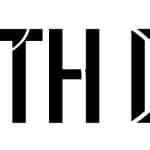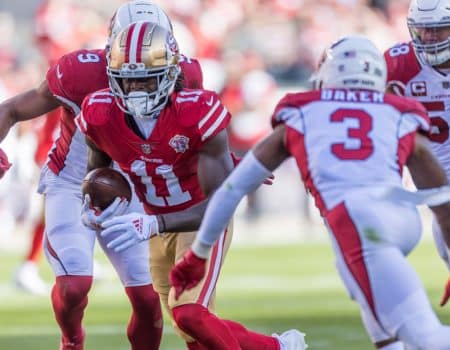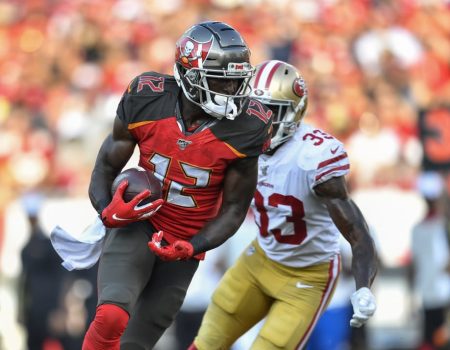At this time of year, most fantasy gamers are enamored with upside, looking for the player that could win them a fantasy championship. It’s important to remember that it’s much easier to lose your fantasy draft in the first few rounds than win it – just ask anyone who drafted Jay Ajayi, DeMarco Murray, Isaiah Crowell, or Ty Montgomery last year.
In this article, we’ll examine players whose current price does not factor in their level of risk (if you insist, you can call them fantasy football busts).
Alex Collins – Baltimore Ravens
Alex Collins was one of the breakout stories of the 2017 season, as he had the eighth-most fantasy points among running backs in the second half of last season. While Collins’ second-half breakout was spectacular, Javorius Allen and Kenneth Dixon will vulture touches from Collins on an anemic Baltimore offense this year. Collins is a one-dimensional running back, as his receiving defense-adjusted yards above replacement and defense-adjusted value over average both were last among running backs with at least 25 targets.
Dixon and Allen are both above average pass-catchers, so Collins will work as a two-down grinder in the Baltimore offense. If Collins falters as the between-the-tackles running back, the Ravens could hand the keys to Dixon, who they have stayed loyal to despite multiple drug and injury issues.
Collins also lacks the athleticism necessary to be an NFL workhorse. With average speed and a 4th percentile burst score, Collins looks more like a journeyman backup than a legitimate NFL starter. He performed well last year despite below average athleticism, but very few running backs post fantasy-relevant numbers with such poor burst; in fact, of the top 60 running backs by points per game last year in the PlayerProfiler database, only LeSean McCoy and Kapri Bibbs had worse burst.
We’ve only seen Collins perform like an RB2 for half a season. In the fourth round, I would rather take someone like Lamar Miller who has a few fantasy-relevant seasons under his belt. The sample size is too small to crown Collins as a surefire RB2 just yet. With so many risk factors affiliated with him, Collins is one of the most overdrafted running backs in fantasy football at his current average draft position.
Jay Ajayi – Philadelphia Eagles
It was a tale of two halves for Jay Ajayi last season. The Boise State product was mediocre on the ground through the first half of the season, averaging 3.4 yards per carry on the Miami Dolphins. After being traded to the Eagles, Ajayi averaged 5.8 yards per carry. Despite the improved efficiency, Ajayi averaged only ten carries and 1.4 receptions per game in Philadelphia.
As shown by 4for4’s TJ Hernandez, yards per carry is one of the least sticky stats on a year-to-year basis for running backs. Volume stats, on the other hand, are near the top of the list. Eagles head coach Doug Pederson has a history of spreading touches among multiple running backs dating back to his time in Kansas City. In his five years as an offensive coordinator or head coach (three years as an OC in Kansas City, two years as a HC in Philadelphia), Pederson RB1s have averaged a 40.4% rushing attempts market share.
As a thought experiment, let’s examine how many carries we can expect from Ajayi this year based on Pederson’s historical usage of running backs and the Eagles rushing volume last season. In 2017, Philadelphia ran the ball 473 times, sixth in the league. If we project the Eagles for similar rushing volume this year and give Ajayi 40.4% of those attempts, he would finish with 191 carries, which would have placed him 21st in the league last year. It’s also notable that Pederson’s RB1s in Philadelphia (i.e. his time as a head coach) have seen a lower rushing attempts market share than when he was an offensive coordinator for the Chiefs.
Put simply, Pederson likes to use a committee, so Ajayi, Corey Clement, and Darren Sproles will all be involved this season. With an unclear path to volume in a crowded backfield, Ajayi is a fade at his current ADP of RB19.
Kenyan Drake – Miami Dolphins
Kenyan Drake broke out during the second half of the 2017 season and finished as the RB32 in PPR formats. However, over the last five weeks of the season, Drake had the eighth-most fantasy points among running backs.
Despite Drake’s elite second half last year, the Dolphins brought in the ageless Frank Gore in free agency and drafted Arizona State running back Kalen Ballage in the fourth round of the draft. Ballage specializes as a pass-catcher, as his college target share placed him in the 82nd percentile. Gore has twelve consecutive seasons with more than 1,000 yards from scrimmage. While Drake sits atop the depth chart, the Dolphins backfield will most likely be a committee. Last year, Kenyan Drake didn’t take over the backfield until after Damien Williams got injured, demonstrating that the Dolphins coaches seem fixated on the idea of a committee approach.
Furthermore, Miami is not a lucrative spot for running backs. Jay Ajayi averaged only 3.4 yards per carry last year before he was traded to the Eagles around midseason. After the trade, Ajayi averaged 5.8 yards per carry. The Dolphins look like one of the worst teams in the NFL on paper and they’ll have to lean on the passing game because of game script this year.
Ronald Jones – Tampa Bay Buccaneers
The Tampa Bay Buccaneers selected USC running back Ronald Jones in the second round of the NFL Draft, but he is a risky proposition in fantasy football drafts this season. Jones’ college target share of 4.3 percent placed him in the 16th percentile among running back prospects, so he hasn’t proven himself as a receiver out of the backfield. numberFire’s JJ Zachariason noted that no successful NFL running back in recent memory had as poor of a receiving share in college as Jones had in 2017.
Furthermore, Jones injured himself running the 40 at the combine, so he doesn’t have full athletic testing data available. Considering all the red flags surrounding him as a prospect, you would think he has a clear path to volume to justify his fifth-round price tag. However, Peyton Barber lingers in Tampa Bay, and head coach Dirk Koetter has stated that Barber is the Buccaneers starting running back. Between the alarm bells ringing around Jones as a prospect and a murky path to volume, Jones’ fifth-round price is much too high.
Chris Carson – Seattle Seahawks
Pete Carroll is all aboard the Chris Carson hype train heading into 2018. Seattle’s head coach has raved about the 2017 seventh-round pick this offseason, claiming that he will start ahead of Rashaad Penny to start the season. However, it is wise to fade the Carson noise considering the Seahawks invested a first-round pick into Penny this offseason. The Seahawks wouldn’t have done that if they believed Carson was their running back of the future.
Furthermore, draft capital matters for running backs. Russell Clay, formerly of Pro Football Focus, noted that first-round running backs are significantly more productive than seventh-round running backs over the course of their careers. In short, the cards are stacked against Carson considering where he was drafted.
Many fantasy gamers are buying Carson because of how effective he was last year before his injury. While Carson was the most productive Seahawks running back last year in a fantasy sense, his advanced rushing efficiency was nothing special. Last season, Carson averaged fewer yards after contact and had a lower success rate on first and second down than fellow Seahawks running Mike Davis.
For now, Penny is sidelined with a broken finger, but Carson is an obvious fade if Penny is healthy. Even if Penny misses significant time, Carson’s average draft position will probably rise enough that I’m not comfortable picking him. Since the news of Penny’s injury only came out recently, the public has not completely reacted yet. Assuming Carson’s price rises with Penny injured, the former seventh-round pick should be avoided in fantasy football drafts.






No Comment! Be the first one.